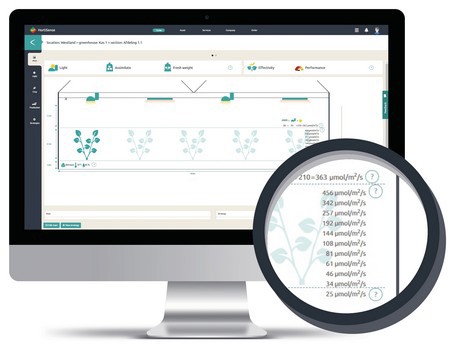Everyone in horticulture knows the rule of thumb that 1% more light results in 1% more yield. That means that as a grower you naturally want your crop to receive as much light as possible, and for there to be gradual light extinction in the crop. "Light extinction is the reduction of the amount of light penetrating vertically through the crop," says Stéphane André, grow light performance consultant at Hortilux. “Particularly in the high-wire cultivation of cucumber, tomato, and sweet pepper, gradual light extinction is crucial. Once a leaf has been in the shade, its ability to make optimum use of the available light and convert it into sugars is reduced. But gradual light extinction doesn't just increase production; it means that the amount of light available – and thus the grow light as well – can be utilised optimally and as efficiently as possible."
Light extinction visualised
However, many growers have little insight into the exact light extinction in the crop, says Hans de Vries, another of Hortilux's grow light performance consultants. “They often don't know exactly how much light any given leaf layer is receiving. They do adjust the Leaf Area Index – the number of square metres of leaf per square metre of greenhouse – according to the season. For example, more leaves are plucked in the winter, to ensure that the limited available light is able to penetrate as far as possible into the crop. But whether this has the desired effect is often unclear, and until recently couldn't be tested."
A special algorithm that Hortilux has developed, and which forms part of the digital platform HortiSense, now helps growers to achieve more insight into and control over the amount of light provided and its extinction in the crop. "The algorithm determines this extinction according to certain parameters entered by the grower," De Vries says. “Specifically, it involves the number of stems per square metre, the number of leaves per stem, and the average leaf area. A PAR sensor is used above the crop to measure the total amount of light provided. A clear outline of light extinction in the crop is then produced.

The algorithm, which was developed based on actual light measurements by growers, is currently suitable for tomato varieties in the coarse and middle segments. "For these varieties we worked with Plant Lighting to develop standardisations for quantities of light," André says. "In the future we will expand this to other varieties, and perhaps also come up with a general model."
Production to a higher level
Naturally, the crucial question is: what is the added value of a visualisation of light extinction in the crop? "To start with, it gives the grower insight into whether the appropriate leaf plucking strategy is in place, and whether every leaf layer is receiving the most possible light. This gives some guidance for making adjustments," says De Vries. “It can also be used to optimise light extinction; as a grower, you have more of a handle on something that is currently often guesswork. And optimal and more even light extinction results in increased production: the more light any given leaf layer receives, the more sugars the leaves will produce and the more fruit can ultimately be harvested. In short: with this method you can raise your production to a higher level.”
LAI optimisation
Although the Leaf Area Index (LAI) is required in order to determine the light extinction, more insight into the light extinction can also assist in determining the correct LAI. “An optimal LAI is very important, which is something that many growers are not aware of," André says. “A too-low LAI inevitably has a negative impact on production, because too much light falls on the ground. But the same is true of a too-high LAI: in that case too many sugars go to the leaves, which also has a negative impact on production. It's important to find the right balance, and that's something which in part depends on the season. A good insight into light extinction in the crop can be useful here."
For more information: Hortilux Schréder B.V.
Hortilux Schréder B.V.
Vlotlaan 412
2681 TV Monster
The Netherlands
T: +31(0)174 286628
W: info@hortilux.com
www.hortilux.com
